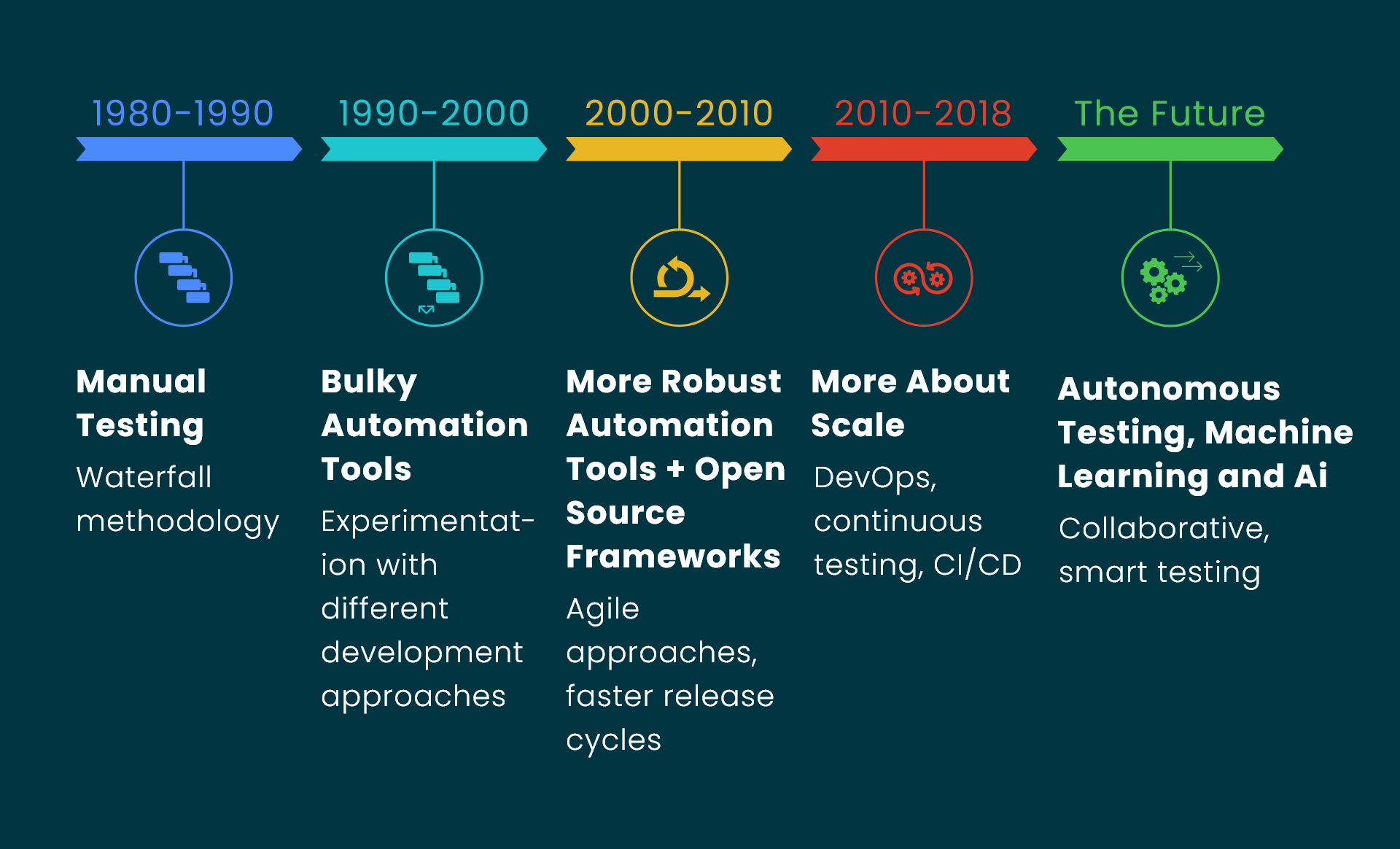AI has exhibited tremendous potential across every sector. Today every digital application typically operates within the Agile development framework or follows the principles of DevOps. This shift has resulted in significantly shorter release cycles and an increased demand to produce high-quality code within much tighter deadlines. To keep pace with the agile mode of development AI in QA has become inevitable.
Why AI in QA Is the Future?
The software quality assurance process has evolved since the 1980 keeping up with changes in software delivery approach and SDLC. The latest entrant is the continuous testing approach to suit the needs of Agile and CI/CD approach. However, continuous testing brings in some challenges to the QA workflow like siloed automation, absence of end-to-end requirement visualization, and high volume of tests. To overcome these challenges an organization should seek complete autonomous QA process.
AI introduces various types of automation to the QA process. For example, developing a test suite and creating test data takes time. Furthermore, a test suite needs to be modified as the test scenarios continue to grow with the scaling and upgradation of the software. Using AI to automatically crawl the software and develop a test suite saves manual effort.
AI can be used to automate visual testing for UI. Normal automation testing finds it difficult to perform this kind of tests and eventually it ends up being manually tested. AI can leverage the power of machine learning to detect patterns that appears appealing to the user.
AI can be used to analyze the treasure of data that CI/CD generates as test reports. It would be very difficult to manually analyze such a bulk amount of data but with the help of AI certain patterns can be traced. This in turn also encourages to run greater number of automated tests.
According to Gartner’s Competitive Landscape Application Testing Services report published on 25 September 2019 by Susanne Matson, “By 2021, intelligent automation will generate an additional 20% savings over what is achievable today in application testing services for end-users.”

Steps to Building AI in QA
The developing of an AI in QA space and automate things involves sequential stages:
Pilot
This is the initial phase, where the QA team identifies the testing objectives and scope. They also collect the required data and select the appropriate testing methods.
Data annotation
This is the process of labeling data so that it can be used to train AI models. The QA team works with domain experts to ensure that the data is accurate and complete.
Testing and validation
In this phase, the QA team develops test algorithms and validates them using a subset of the training data. They also evaluate the performance of the AI models in different scenarios.
Scaled deployment to production
Once the AI models are tested and validated, they are deployed to production. This involves scaling the models to handle the volume of data and traffic.
Retraining
AI models need to be retrained regularly to ensure that they continue to perform well. The QA team monitors the performance of the models and retrains them when necessary.
Benefits of AI in QA and Testing
AI powered tools can mimic human behavior and provide relaxation from the ordeals of manual testing. Some of the benefits that AI in QA brings in are:
Saves time
Utilizing AI in Quality Assurance has the potential to reduce test fatigue significantly, allowing you to reclaim as much as 60% of your valuable time and effort. This is achieved through the elimination of redundant test cases and the repetition of smoke tests and regression tests. Consequently, you’ll experience heightened productivity. By leveraging machine learning algorithms to identify potential risks within the functionality under examination, the platform also provides valuable guidance on prioritizing test cases.
Provides deep insights before release
Artificial intelligence equips product development team with the capability to assess similar apps and software, identifying the pivotal elements behind their market triumph. This insight enables the creation of tailored test cases, taking into account market requirements, ensuring the application or software remains robust and capable of meeting specific objectives without glitches.
Improves test case authoring
AI enhances the quality of your automated test cases, providing efficient and easily manageable test scenarios. Unlike traditional methods, AI enables developers to explore additional test case possibilities. By swiftly analyzing project data, AI in quality control empowers developers to discover novel approaches to designing test cases within seconds.
Detects vulnerabilities
AI aids in forecasting potential failure points and provides engineers with valuable insights into areas requiring heightened testing attention. Additionally, AI offers insights gleaned from historical events related to the tested application, utilizing production data and past project experiences.
Business process assurance
AI verifies individual features and functionalities to ensure alignment with both business and consumer requirements. Furthermore, it assesses critical business processes across the entire organization and graphically plots application or service risks on a risk matrix. This dashboard offers a comprehensive view of risks and vulnerabilities within a company’s business operations.
Conclusion
Software testing has undergone significant improvements with the integration of AI in QA, becoming faster, more adept at bug detection, and demanding less effort from human developers. AI empowers you to conduct software testing at an unprecedented speed, making it an ideal solution for time-sensitive situations. In an agile landscape where speed is of the essence in product release, AI emerges as the perfect tool to elevate your software’s performance.
